Ultra-Powerful Road Blasters!
The Clearwater Krista lights use the latest generation of LEDs for retina-melting power at minimum draw.
The light output can be varied by turning a rotating dial or the lights can be turned off completely.
The quality of construction, mounting hardware and the light output are outstanding.
In the 12 or so years that Burn and I have been messing around with LED motorcycle lighting we’ve witnessed an incredible evolution of the technology.
What was once considered a novelty for vehicle use is now a mainstream lighting technology, with LED tail lights now commonly used on many types of vehicles.
The newest generation of LEDs now power auxiliary driving lights with output that would have been unimaginable only a couple of years ago.
The Clearwater “Krista” lights are an example of how far LED lighting has come.
Their light output is simply amazing and makes even the most powerful motorcycle headlight look wimpy.
The Clearwater Krista light units are made in the U.S.A., machined from aluminum billet and hard anodized and powder coated. The wiring and connectors are aircraft grade and the wiring is silver plated and uses Teflon insulation, according to Clearwater.
These are big, mean-looking lights, measuring 95 mm (3.75″) in diameter and 72 mm (2.8″) deep. They have thick acrylic lens covers that are replaceable and Clearwater also has amber-colored lenses for the units.
The lights come with powder-coated U-shaped brackets and the kit includes all the wiring and high-quality stainless steel hardware.
An on-off switch and the dimmer rotator is also provided.
The dimmer controls a specially designed digital circuit in the Krista lights that allows the light output of each light to be varied.rake/tail light draws 21 Watts.
So even an electrical wimp like the Suzuki DR650 (blog) has enough juice left over to handle the Krista lights; its alternator puts out 200 Watts at 5,000 RPM, according to the shop manual.
A rough calculation for the Dclaimed draw is only 35 Watts.
And there’s a new 250-Watt stator available for the DR650; we ordered one of those also just to be on the safe side.
I’m not worried about heated grips or clothing because I use the excellent Gerbings Hybrid battery heated gloves (review) or the Warmthru G4 battery heated gloves (review) in the winter, along my current favorite cold-weather liner, the Gerbings “Core Heat” battery heated vest (review).
One of the major benefits of LED technology is that it provides lighting options that are not otherwise available for motorcycles with limited electrical systems.
One other big benefit of the Krista LED light kit is the variable output controller.
This allows the lights to be used on low power during the day to serve as visibility or marker lights, or half-power can be used with either the low or high beam at night, or full power can be chosen for maximum output.
Note that the beam pattern of the Krista lights is broad and unfocused because the lights were designed primarily for off-road use for illuminating dark trails, which is how the majority of these powerful auxiliary lights are sold.
You do not want to use the Krista lights at full power if there is oncoming traffic and you don’t want to peer directly into the lights either — they are very, very bright.
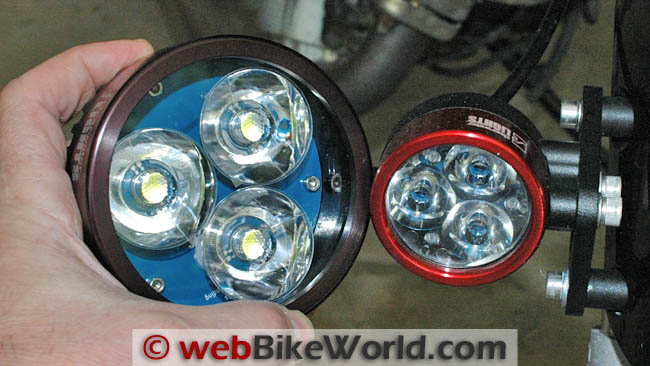
Where to Buy Clearwater Krista Lights
Check Reviews & Prices on AmazonAlso Shop for: LED Lights and Bulbs, Auxiliary Driving Lights, Motorcycle LED Headlights
Let There Be Light!
Let’s get right to it: following are photos taken at night of the stock 55 Watt low beam halogen light output of the Suzuki DR650, the 60 Watt halogen high beam and then the Krista lights at full power with the DR650 high beam.
I think the results are obvious.
The DR650 actually has a decent low and high beam, as motorcycle lights go. The reflector is nicely shaped to put out a good pattern. But the Clearwater Krista lights show a dramatic difference in light output for this bike.
Each of these photos was taken at a focal length of 46 mm (35 mm equivalent) at f6.3 and a 0.5 second shutter speed at ISO800.
This means the light outputs are comparable, as the camera did not try to compensate the exposure between the different headlight outputs.
The photos were reduced to 650 pixels in width and slightly sharpened but were not otherwise modified.
The bike is on its side stand with no rider, so the light output is slightly lower than it would be with weight on the bike, but it works for comparison purposes.
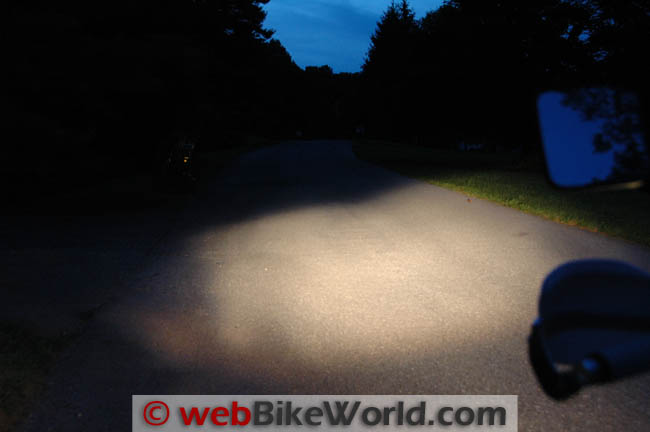
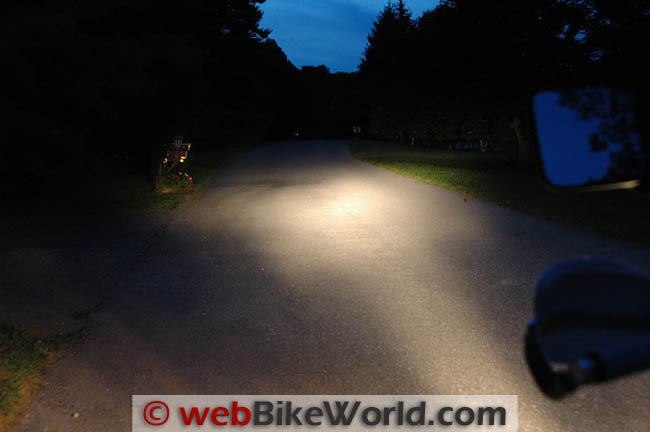

The Clearwater Krista LED Light Kit
The Clearwater Krista light kit will fit many different types of motorcycles. Clearwater has brackets and fittings for many different popular motorcycles and generic kits for others.
The kit shown here was developed specifically for the Suzuki DR650.
The front reflector mounts on the DR650 are removed to install the Clearwater CNC-machined, powder-coated heavy-duty brackets to hold the Krista lights.
This makes an excellent mounting system with very little effort required by the owner — no muss, no fuss, bolt ’em up and you’re ready to rock!
This is the lighting system to have for DR650 owners because it’s specifically tailored for the bike and it makes a beautiful installation.
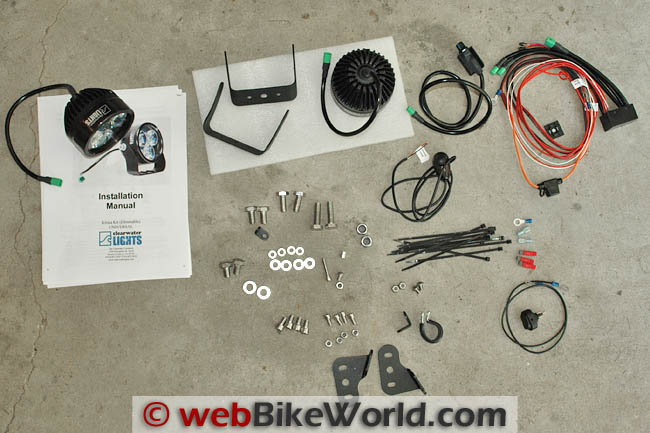
Where to Buy Clearwater Krista Lights
Check Reviews & Prices on AmazonAlso Shop for: LED Lights and Bulbs, Auxiliary Driving Lights, Motorcycle LED Headlights
Installing the Clearwater LED Lights
The Krista kit comes with an extensive set of stainless steel hardware and the wiring harnesses necessary to install the lights on many different types of motorcycles.
Yet another benefit of the DR650 is the ease of installation for electrical accessories. Everything on this bike is easily accessible, and it didn’t take long at all to tap into the bike’s electrical system (using Posi-Lock Connectors purchased from webBikeWorld.com, of course!) and get it all working.
Clearwater has developed a color installation guide for the Krista lights, also available as a .pdf file download from their website.
Basically, all you need to do to get the lights working is to mount the brackets and install the lights.
The fused wiring harness, which includes a relay, is connected directly to the motorcycle’s battery.
The harness has very professional-looking, OE (original equipment) type snap connectors (the green connectors shown in the photo) so everything clicks together with a minimum of fuss for a clean-looking job.
NOTE: The Krista lights will only reach maximum power when they are connected to the high beam power wire and when the high beams are switched on. Tap into the high beam wire with the white wire in the relay bundle for the Krista lights, using a Posi-Tap.
The dimmer switch will take a single Krista light from 120 lumens on the lowest setting to 1,320 lumens at the highest rotary dial dimmer switch setting, then up to 2400 lumens (4,800 lumens total for the two lights) when the high beams are engaged.
The system includes a lighted on/off switch to turn the lights on and a rheostat-type knob, similar to the dial used on the Clearwater Glenda LED lights (review) we installed on the Ducati Multistrada 620 (blog) and which have been in use ever since.
Since dashboard space is very limited on a bike like the DR650, we had to get creative but the “volume” knob mounts easily on the bolt that holds the left-hand mirror.
Finding a location to mount the on/off switch was the biggest problem and I ended up using some silicone adhesive and a cable tie to secure it to the mirror upright as shown in the photo below.
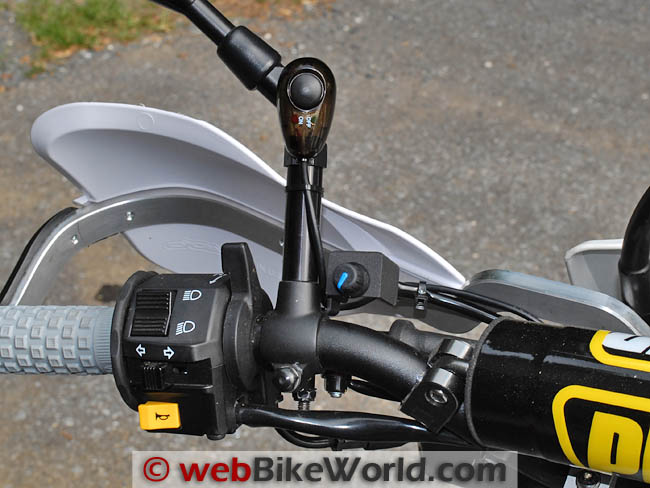
Lighting Options
The Krista wiring system has two optional wires; one can be used to tap into the high beam, which will cause the Krista lights to also go immediately to their highest power setting whenever the motorcycle’s high beams are on or flashed.
I opted to install that one.
The other wire can be used to tap into the motorcycle’s horn wire, which will flash the Krista lights when the horn button is pressed. I didn’t install that one.
The instructions also provide guidance for connecting two sets of Krista lights or a Clearwater Glenda/Krista light pairing.
This would give you a wide, low-beam driving pattern with the Glenda lights and the powerful long-distance light provided by the Krista lights.
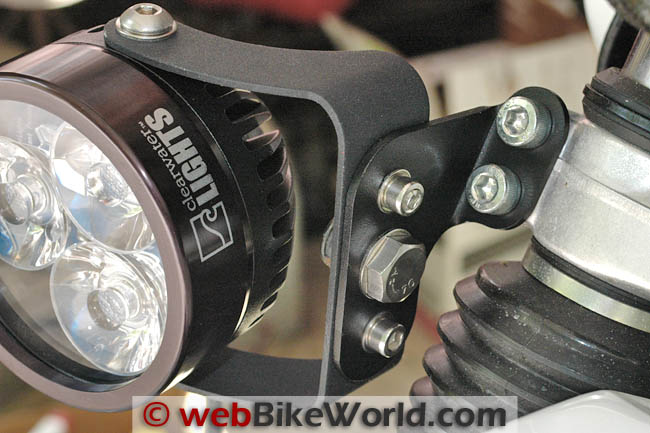
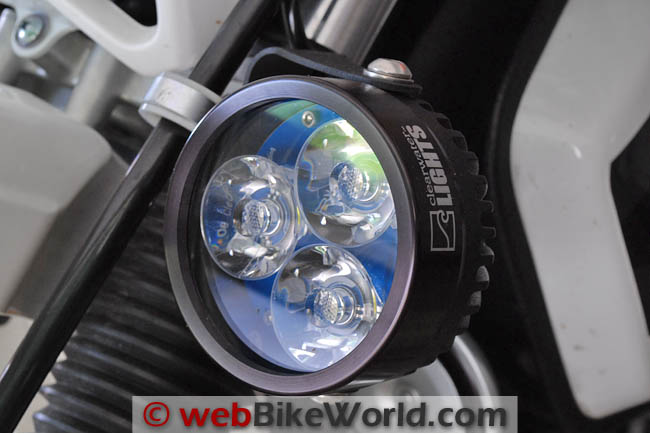
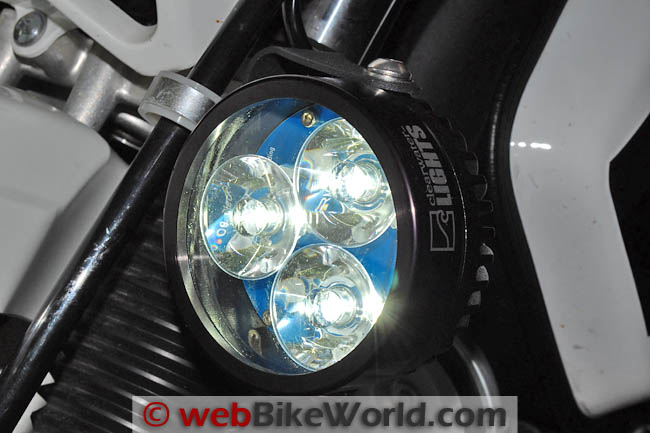
Where to Buy Clearwater Krista Lights
Check Reviews & Prices on AmazonAlso Shop for: LED Lights and Bulbs, Auxiliary Driving Lights, Motorcycle LED Headlights
Technical Background Information on the Krista Lights
I had a few questions for Clearwater about the “new generation” of LED lights and I’ll add an edited version of that discussion here.
Any thoughts on the lumens per Watt output of the Krista lights?
Lumens per watt (often called the Luminous Efficacy) is about 80-90 LPW. Some LEDs claim more, but that is under specific conditions.
Lumens per Watt in the lab and lumens per Watt in the real world are often different.
Thermal management and power supply design play into the equation. Optics are another factor that makes lumen to lumen comparison somewhat confusing.
The “directivity” of the light often plays a big role is “how bright” a light appears. And, the lumens per Watt ratio changes as the light is driven harder. For example.
A 12-Watt LED produces the “most” light at 12 Watts, but it’s efficiency is higher at, say, 6 Watts. So, the lumens per watt may be better at a lower power, but less total light is produced.
A trade-off is needed. Making sure the power supply is optimally designed adds even more efficiency to the system.
LED lights that have a wide range of “input” voltages are typically less efficient than specifically designed 12 Volt or 24 Volt lights.
Clearwater lights can operate at higher voltages, but they are optimized for 12 Volt DC systems.
How did you arrive at the “180 Watts of halogen light” equivalent? Is this real or estimated?
The Luminous Efficacy of a halogen bulb is about 18-22. A properly designed LED/power supply achieves 80-100 (about 5x).
The 180 Watts “equivalent” is an estimate based on real world viewing. A panel of judges (ok, a few friends of mine!) did some viewing of various lights at night.
Photometers were used to help quantify our findings, but due to the varying distribution patterns (directivity) of the different lights, it was difficult to make accurate measurements.
Basically, we set up our lights on a deserted road that had trees, fence posts and some reflective signs. A Krista was used as the base light. We then we compared groups of 50-Watt halogen lights until we felt the “perceived” light was equal.
When we got to 3 lights, Krista was judged to be still brighter.
Four 50-Watt halogen lights seemed to produce more light — but just slightly.
So the 180-Watt figure was determined. Of course, three 50-Watt lights produce more light than a single 150-Watt light due to reflector efficiency and thermal losses.
Halogen light produces a “warmer” light and the Krista produces a much “whiter” light. The human eye is more sensitive to the Krista light (6300 degrees Kelvin). So, it produces more perceived light down the road.
The added reflective efficiency coming back from 3M reflector road signs really made the Krista seem to produce even more light.
Taking the 5x factor of Efficacy (Halogen = 18, LED =90) into consideration, the 36 Watt to 180 Watt comparison seems accurate.
Regarding the power consumption of the Krista lights
Each Krista LED uses 12 Watts on full power. With the dimmer engaged, the range is from 15% to 85% of the full 36 Watts.
The sweep of the volume pot (rheostat) is calibrated (again by the same group of experts) to be “linear” over the sweep range.
What I mean by this is that we programmed each of the 256 dimming steps not only by what the calculated log vs. linear relationship is, but also by including the “human” factor.
The bandwidth of light we use is in a more sensitive range of the human vision. And we wanted the “12 o’clock” position on the dial to be perceived as close to what one thinks of as 1/2 power.
So, the end result was a plot that did not conform to what was calculated.
We tried very hard to make the linear rotation of the pot make sense.
After all, as an Audio guy, I like rotating volume KNOBS. I hate push button volume controls! And, you can adjust the knob wearing a wet leather glove.
So on high beam (no PWM dimming) each Krista uses 36 Watts. A pair uses 72 Watts.
Remember, if you use the high beam option, activation of your factory high beam will disengaged by the PWM dimming function and the pot will be bypassed.
The horn option does the same. On low beam, with the pot turned up full, each Krista uses about 30 Watts (It’s difficult to measure as the current is pulsing 250 times per second with an 85% duty cycle).
Full (regulated) current (2800 mA) is driving the LEDs. The dimmer just determines how long the current is off vs. on.
The human eye does not see these fast flashes. It only averages the light pulses and it “thinks” the light is dimming.
A simple current meter does not have the resolution to measure this. Our HP digital scope with a $5,000 current probe can! On low beam, with the pot turned fully CCW, each Krista uses about 5 Watts. A pair uses 10 Watts.
The entire output vs. linear rotation can be changed for any new upcoming lights too, as it is all digital.
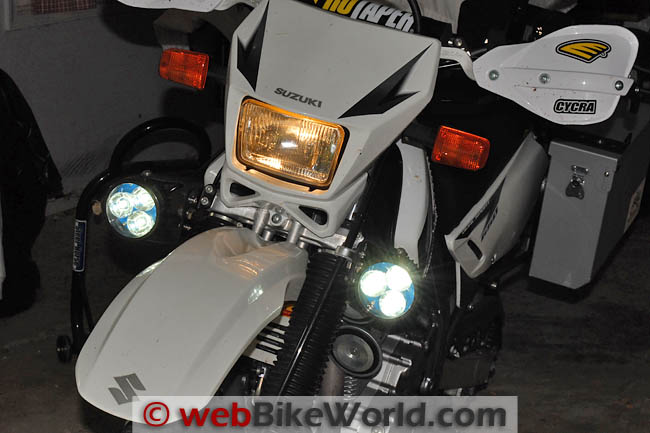
Conclusion
The new Clearwater Krista LED lights put out an amazing amount of light with a minimal amount of current draw from the motorcycle.
Having lights with this kind of output on a motorcycle like the Suzuki DR650, with its limited electrical capacity, is a major benefit, as is the ability to vary the light output for both day and night use.
The lights are beautifully made and the kit, the wiring harnesses and the hardware are of outstanding quality.
The only issue may be the price of the kit, but the Krista lights are in an entirely different league than most of the other cheap LED light kits available.
More wBW: Clearwater Erica Lights Review | Suzuki DR650SE Blog
Where to Buy Clearwater Krista Lights
Check Reviews & Prices on AmazonAlso Shop for: LED Lights and Bulbs, Auxiliary Driving Lights, Motorcycle LED Headlights
Owner Comments and Feedback
See details on submitting comments.
From “J” (August 2011): “Love your site! Both Glenda & Krista ended up on my new Super Tenere. These lights are incredible.”



No Comment